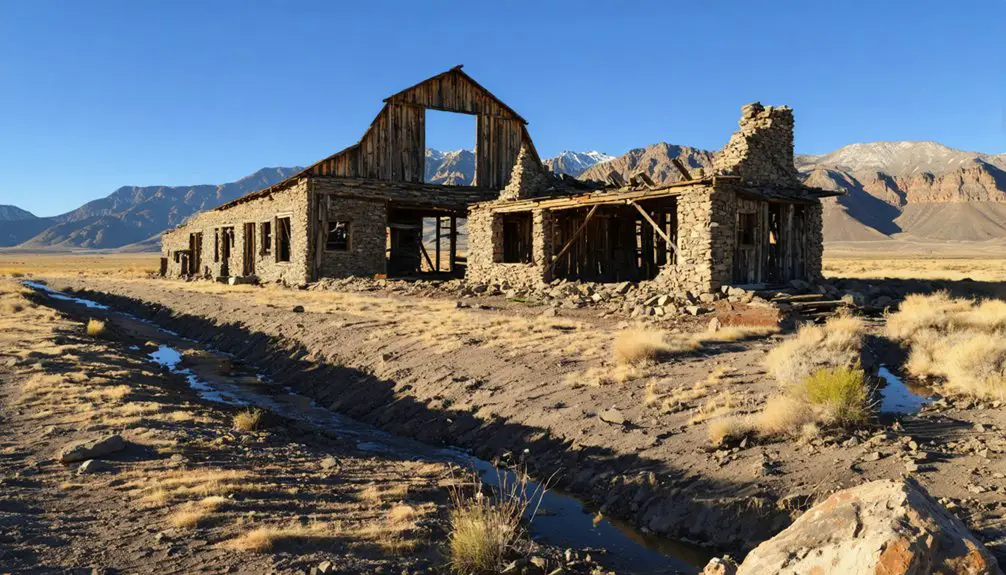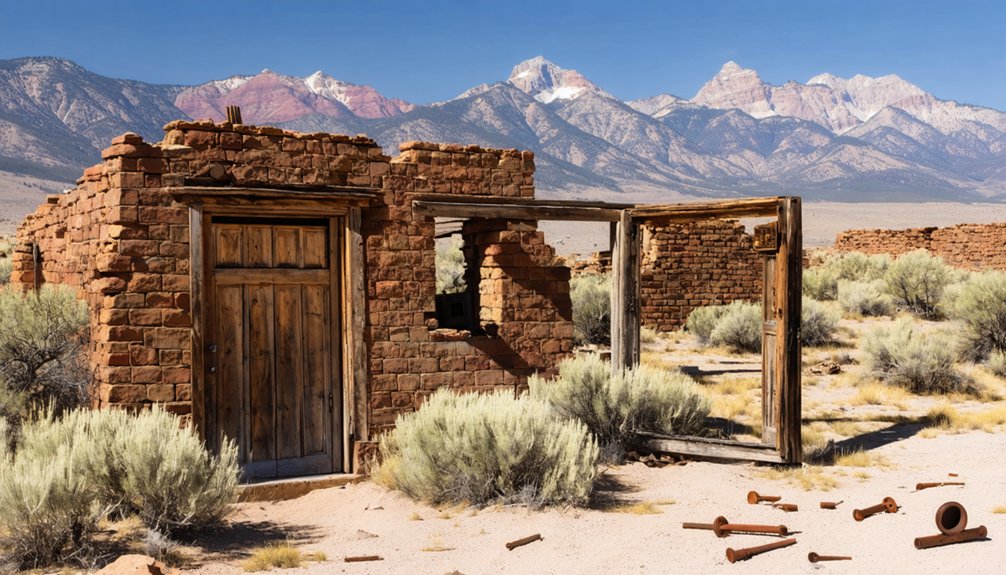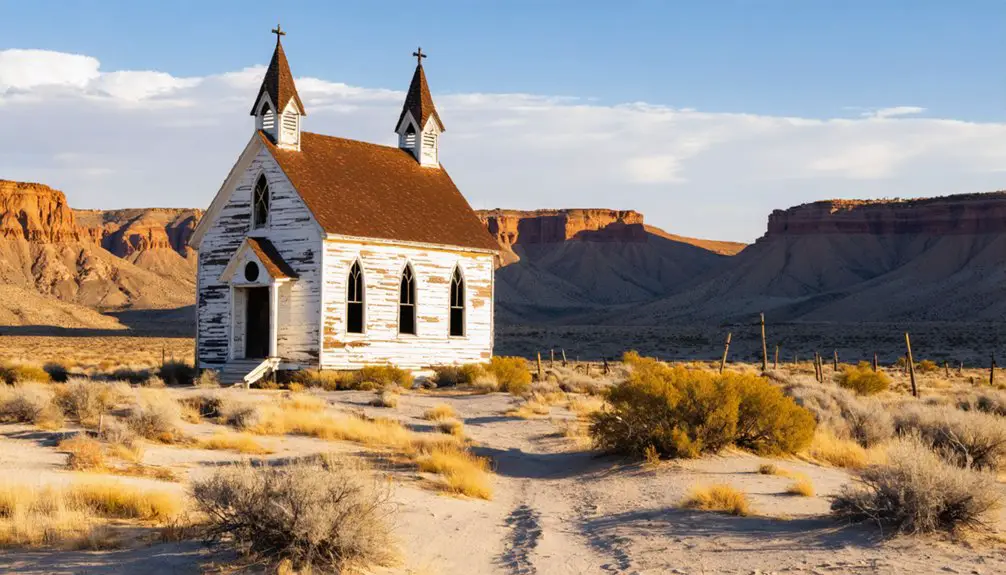You’ll find Hebron’s haunting remains at Shoal Creek’s fork in southwestern Utah, where Mormon pioneers established a thriving settlement in 1862. The town flourished for 40 years through ranching and agriculture until a devastating 1902 earthquake destroyed its water infrastructure. Today, scattered brick fragments, building foundations, and eroded gullies mark this once-bustling frontier community. The site’s rich archaeological record reveals layers of pioneer life waiting to be uncovered.
Key Takeaways
- Hebron was a Mormon settlement established in 1862 near Shoal Creek, Utah, which thrived until a devastating earthquake in 1902.
- The ghost town’s remains include brick fragments, building debris, and traces of the 1898 church structure.
- Most residents relocated to Enterprise after the 1902 earthquake destroyed water infrastructure and led to water rights sales.
- Hebron served as an economic hub for livestock production and agricultural trade before its decline.
- The Daughters of Utah Pioneers Museum in Enterprise preserves artifacts and historical documents from Hebron’s pioneer era.
The Birth of Shoal Creek Settlement
While searching for suitable grazing land in 1862, John and Charles Pulsipher discovered the promising Shoal Creek area during their duties herding LDS Church livestock.
You’ll find their pioneer settlement choice was strategic – the location offered abundant water from mountain springs, fertile soil for crops, and excellent grazing conditions for cattle and horses.
The local Paiute Indians welcomed this early ranching venture, supporting the settlers’ presence in their territory.
By fall of 1862, several families had constructed homes, establishing the foundation of the Shoal Creek community.
The pioneering spirit took root as families built their homesteads, laying the groundwork for a vibrant Shoal Creek settlement.
Their father, Zera Pulsipher, a distinguished LDS leader, arrived later that year to guide the settlement’s religious development.
Like the historic city of Hebron in Palestine, the community relied heavily on limestone quarries for building materials and economic development.
The settlement was positioned at 5475 feet elevation, offering a unique vantage point in the small valley.
The combination of natural resources, Native American cooperation, and determined leadership transformed this grazing outpost into a burgeoning ranching community.
From Fort to Frontier Town
When escalating tensions during the Black Hawk War threatened settler safety in 1866, the residents of Shoal Creek constructed a defensive fort that would transform their ranching outpost into an essential frontier stronghold.
You’ll find that this fort construction marked a pivotal shift, as settlers from nearby Clover Valley sought refuge within its walls, greatly boosting the population and strategic importance of the settlement.
The growing community was officially surveyed in 1868 and renamed to Hebron, drawing inspiration from the ancient biblical city in Palestine.
Mormon Pioneers and Religious Life
Because religious conviction drove Mormon settlement throughout Utah Territory, Hebron’s establishment in the 1860s closely followed LDS Church organizational patterns. Under the direction of Apostle Erastus Snow and local leaders like the Pulsiphers, the faithful perseverance of pioneers transformed this frontier outpost into a structured religious community. Like the original Mormon pioneers who faced religious persecution in the Midwest, these settlers sought to build a place where they could worship freely. Following the example of Brigham Young’s 1847 pioneers, the community was organized into hundreds and fifties for effective management.
Your religious identity shaped every aspect of daily life, from land distribution to education.
- The 1867 schoolhouse served as both an educational center and gathering place for religious instruction.
- Church leaders managed temporal affairs, including essential livestock herds and communal decision-making.
- During the Black Hawk War, settlers built a defensive fort while maintaining their commitment to missionary work among local Paiutes.
The settlement reflected broader LDS goals of establishing self-sufficient, faith-centered communities where members could freely practice their beliefs without persecution.
Daily Life in a Desert Community
If you’d visited Hebron in the 1870s, you’d have found families tending to their 2-3 acre fenced plots, carefully managing precious water from Shoal Creek to sustain gardens and fodder crops in the harsh desert environment.
Your daily routine would have centered around the community’s log structures, including homes surrounded by gardens and the schoolhouse where social gatherings took place. Much like the residents of Saro Gordo mining town, these pioneers demonstrated remarkable resilience living in remote desert conditions.
Just as peach orchards once flourished in early Mosida, you’d have participated in communal activities like church meetings, shared labor on farms, and gatherings at the local stores and hotel, which helped maintain social bonds despite the settlement’s isolation.
Water and Farming Challenges
Though Hebron’s settlers faced numerous challenges in establishing their desert community, securing a reliable water supply proved to be their most persistent obstacle. The community’s initial focus on ranching helped them adapt to the limited agricultural possibilities at their high-altitude location. After experiencing seven distinct tremors, many residents feared their homes would collapse if they stayed indoors overnight.
You’ll find that water scarcity dictated every aspect of their farming adaptation efforts, from dividing land into small 2-3 acre plots to carefully planning irrigation ditches. Despite the harsh desert conditions, settlers managed to grow gardens and fodder to support their livestock.
- Relied on a mountain spring three miles south until a formal water system’s installation in 1914
- Created a network of locally dug ditches to maximize limited water resources
- Struggled with competing water claims, including disputes over Shoal Creek diversion
The 1902 earthquake ultimately devastated their water infrastructure, and the community sold their water rights to Enterprise Reservoir Company in 1904, marking the beginning of Hebron’s end.
Community Social Activities
Despite the harsh realities of water scarcity, Hebron’s residents built a vibrant social framework centered around their LDS church, schools, and commercial establishments.
You’d find regular social gatherings at the 1898 brick church, where Apostle Erastus Snow established formal meetings that served both spiritual and practical needs.
The log schoolhouse, built in 1867, became a significant hub for youth education and community events.
Local stores and the hotel weren’t just business venues – they transformed into informal meeting spots where you could exchange news and stories.
During challenging times, like the 1872 diphtheria outbreak, community cohesion proved essential for survival.
The residents adapted their social patterns, strengthening family bonds through home visits and maintaining connections despite their scattered desert locations.
The town’s telegraph office became a vital communication center that connected residents to both St. George and Nevada, fostering regional relationships.
Home and Family Life
How did Hebron’s pioneering families adapt to the harsh desert environment? They developed resilient family dynamics centered around self-sufficiency and shared labor.
You’d find men managing livestock operations while women maintained households and often served as teachers. Children balanced their schooling with essential contributions to farming and ranching duties.
- Your brick home, built from locally-made materials, would protect you from the elements while connecting you to community structures like the schoolhouse and telegraph office.
- You’d tend to your garden daily, growing food for your family and fodder for livestock.
- Your family’s survival would depend on adapting domestic roles, with everyone pitching in for ranching, education, and household management.
The cooperative nature of family life proved essential in this frontier setting, where daily tasks required everyone’s participation to overcome environmental challenges.
Economic Hub and Regional Trade
While operating between 1862 and 1902, Hebron emerged as an essential economic hub centered around livestock production and agricultural trade.
You’d find LDS families driving cattle through Shoal Creek, establishing trade routes that connected the town to regional markets. Despite religious opposition to non-farming commerce, Hebron’s economic complexity grew as it supplied silver mining camps in eastern Nevada and Utah.
The town’s strategic location at Shoal Creek’s fork junction facilitated commerce, with freight offices and stores supporting regional distribution.
You could see evidence of this connectivity through the telegraph office established in 1872. Agricultural production, particularly dairying and gardens, thrived despite water scarcity, providing essential supplies to neighboring communities like Pioche and Silver Reef until earthquake damage in 1902 disrupted operations.
Natural Disasters and Decline

Before the devastating 1902 earthquake sealed Hebron’s fate, you’d find the town already grappling with significant challenges that foreshadowed its decline. The population had dwindled from 110 to 79 between 1870 and 1890, reflecting mounting environmental and social pressures.
When the earthquake struck, it delivered the final blow to this struggling settlement.
- The earthquake aftermath left brick buildings in ruins, including the 1898 church.
- You’ll find most residents relocated to Enterprise, about 6 miles east.
- Local legends of Gadianton Robbers and evil spirits added psychological weight to the natural disaster.
The population decline accelerated after the earthquake, with residents abandoning their damaged homes.
Limited water resources, valley constraints, and previous social challenges had already weakened the community’s resilience, making recovery impossible after this catastrophic event.
Legacy in Stone and Memory
Today, physical remnants and cultural memories stand as proofs to Hebron’s pioneering spirit. You’ll find the town’s legacy preserved in locally-made brick structures, including the 1898 church building that exemplifies Mormon architectural heritage.
The Daughters of Utah Pioneers Museum in Enterprise safeguards artifacts and documents that tell stories of determination and resilience.
The cultural heritage runs deeper than stone, intertwining with ghost stories and local folklore. You’ll hear tales of “evil spirits” and mysterious presences, which early settlers attributed to ancient Gadianton Robbers.
These narratives, while haunting, reflect how residents made sense of their hardships. Archaeological documentation and historical monuments now preserve Hebron’s memory, transforming a once-thriving pioneer settlement into a representation of western frontier life.
Archaeological Remains Today

Since devastating earthquakes struck in 1902 and 1906, Hebron’s archaeological footprint has diminished to scattered remnants at the junction of Shoal Creek’s west and south forks.
You’ll find the site’s archaeological context severely compromised by extensive gully erosion that’s washed away Main Street and most foundational remains.
Site preservation challenges stem from both natural disasters and ongoing environmental degradation.
Preserving historic sites requires constant vigilance against the dual threats of catastrophic events and the slow wearing away of time.
- Brick fragments and building debris mark where the 1898 church once stood
- Large-scale soil disruption has complicated efforts to maintain stratigraphic integrity
- Relocated structures in nearby Enterprise now preserve aspects of Hebron’s material culture
What you’ll encounter today are mostly disturbed earth patterns and faint traces of constructed spaces, rather than intact buildings or well-preserved artifacts that could tell Hebron’s complete story.
Frequently Asked Questions
Are There Any Known Photographs of Hebron During Its Active Years?
Like scattered puzzle pieces from the past, you’ll find historic imagery of Hebron’s active years mainly through the Forest Service’s 1903 town photograph, though town archives haven’t revealed many other documented images.
What Happened to the Residents’ Graves After the Town Was Abandoned?
You’ll find that most graves remained undisturbed at their original location, as there’s no evidence of grave relocation or cemetery preservation efforts after Hebron’s abandonment between 1902-1905.
Did Any Original Buildings or Structures Survive Until Modern Times?
You’ll find the 1898 brick church still stands, preserved as a museum by the Daughters of Utah Pioneers. Beyond this architectural remnant, few historic structures survived the devastating 1902 earthquake.
Were There Any Famous or Notable People Born in Hebron?
You won’t find any famous residents born in Hebron during its brief existence. While notable events shaped the town, historical records show only local pioneers and church leaders gained regional recognition.
Can Visitors Legally Explore the Hebron Ghost Town Site Today?
You can explore Hebron’s exterior areas with caution, but there aren’t clear visitor restrictions or posted guidelines. It’s best to avoid entering unstable structures and respect any no-trespassing signs you encounter.
References
- https://usgenwebsites.org/UTWashington/towns/hebron.html
- https://en.wikipedia.org/wiki/Hebron
- https://onlineutah.us/hebronhistory.shtml
- https://wchsutah.org/towns/hebron2.pdf
- https://wchsutah.org/towns/hebron.php
- https://historytogo.utah.gov/enterprise/
- https://en.wikipedia.org/wiki/Mormon_pioneers
- https://historytogo.utah.gov/pioneers/
- https://blog.lib.utah.edu/175-years-ago-today-journey-of-the-utah-pioneers/
- https://www.youtube.com/watch?v=c0RvVJfNz7A



